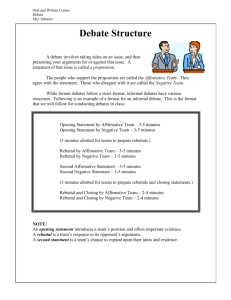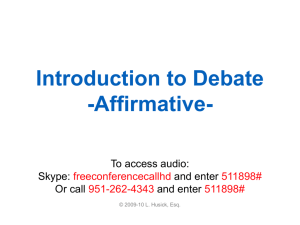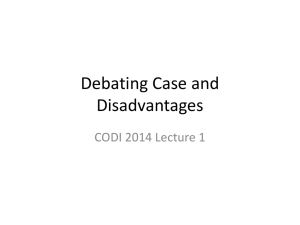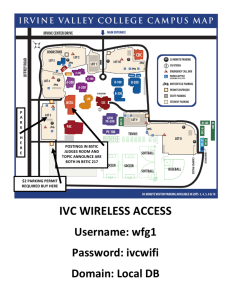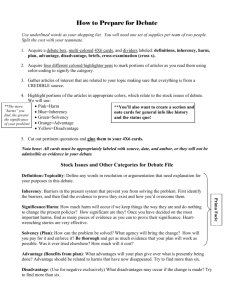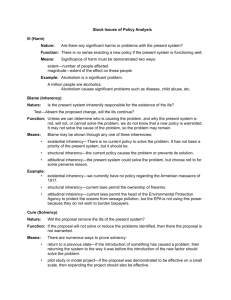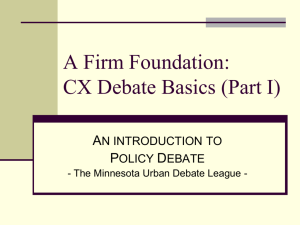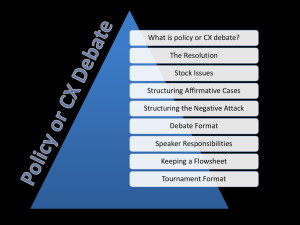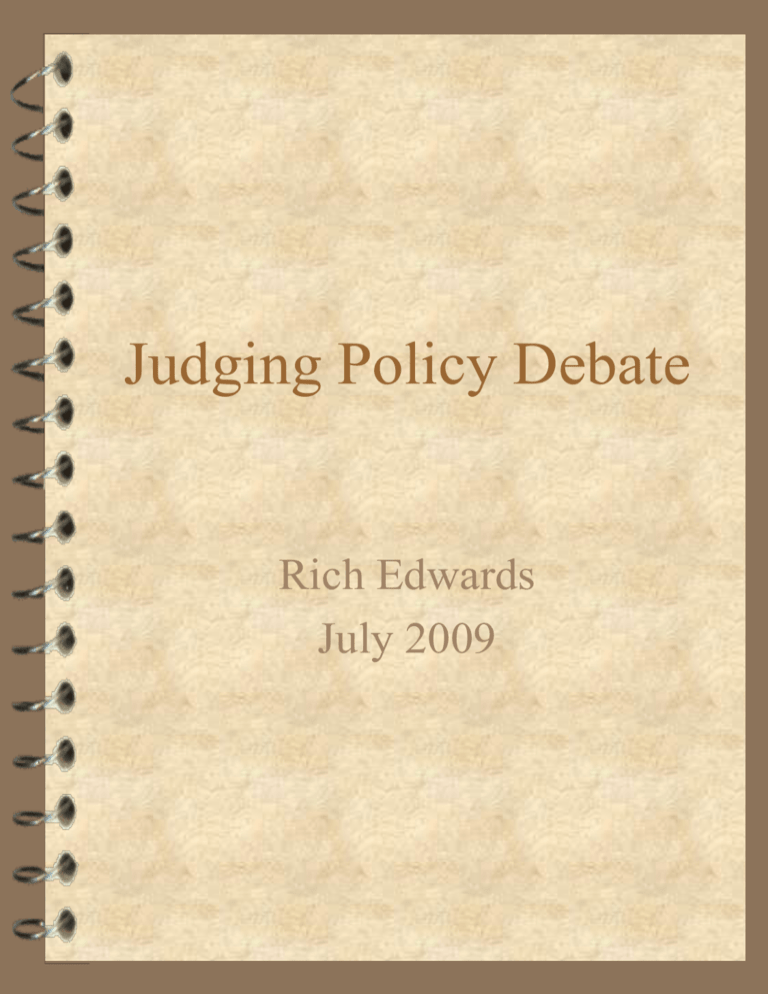
Judging Policy Debate
Rich Edwards
July 2009
Times of Speeches
Both teams get a total of 8 min Prep Time divided
throughout the debate Round.
1st Affirmative Constructive 8 min
CX Cross Examination 3 min
1st Negative Constructive 8 min
CX Cross Examination 3 min
2nd Affirmative Constructive 8 min
CX Cross Examination 3 min
2nd Negative Constructive 8 min
Cross Examination
1st Negative Rebuttal 5 min
1st Affirmative Rebuttal 5 min
2nd Negative Rebuttal 5 min
2nd Affirmative Rebuttal
Judging paradigms
What is important to you
as a Judge??
Stock Issues: Legal Model
–
–
–
–
–
Topicality
Significance of Harm
Inherency
Solvency
Advantage Over Disadvantage
Policy Making: Legislative Model
– Weigh advantages versus disadvantages
Hypothesis Testing: Social Science Model
– Each negative position (some of which may be
contradictory) tests the truth of the affirmative; it
must stand good against all tests to be true.
Tabula Rasa: Democracy/Anarchy Model
– Whatever basis for decision the debaters can agree
on will be used as a judging standard.
Game Player: Gaming Model
– Debate is a rule-governed game; you play by (and
are judged by) the rules.
Evaluating Topicality
Standards
–
–
–
–
–
Precision
Each word has meaning
Debatability
Notice/Fairness
Reasonability
Violation
– What word(s) in the resolution have been
violated?
– How should these words properly be defined?
– Applying the relevant standard, why does the
definition offered demonstrate an aff violation?
Impact
– Why is this a voting issue?
Extratopicality
– Does the plan do the resolution and MORE?
Evaluating Inherency
Structural Inherency
– Law: Existing law restricts asset
accumulation for persons living in
poverty
– Existing qualification standards for
Medicaid, food stamps, and numerous
other poverty programs limits assets to a
total of $2,000.
Attitudinal Inherency
– The Obama administration has zeroed
out all federal funding for abstinencebased sex education programs (for cases
proposing support of abstinence-based
sex education as a solution to teen
pregnancy)
Evaluating Solvency
Types of solvency arguments
– Impracticability: The plan will not work as
planned (the plan calls for the use of abstinencebased sex education as a solution to teen
pregnancy, but studies show that such sex
education programs fail to reduce pregnancy
rates)
– Insufficiency: Other causes will remain and
perpetuate the problem (Even if job training
programs can teach important skills to
unemployed persons, no benefit will be achieved
given that the economic downturn has made jobs
unavailable. The key limiting problem is not the
lack of job skills, but rather the shortage of good
jobs in the private marketplace).
– Counterproductivity: This type of solvency
argument holds that an attempt to solve the
problem will actually make it worse (Any effort
to increase assistance for persons in poverty will
create dependency on the government, making it
less likely that low income persons will escape
poverty)
Evaluating Disads
Link
– Why will the plan cause this?
Uniqueness:
– Would the disad happen anyway, even
without the plan?
Brink/Linearity
– Is there any reason to believe that we
are at a critical point or is the negative
simply saying that the plan would cause
more of something which is already
happening?
Impact
– Why would this be bad?
– Why would it outweigh the case
advantages?
Evaluating Counterplans
Nontopicality
– Is it necessary to be nontopical?
– What word(s) in the resolution does the
counterplan fail to meet?
Competitiveness
– Mutual Exclusivity
– Net Benefits
– Permutations
Types
– Agent (state or international
counterplans)
– Exclusion (exclude persons such as
Native Americans, illegal immigrants,
etc.)
– Plan inclusive (do the plan in such a
way as to avoid the politics Disad)
Evaluating Kritiks
Types
– Language
– Causation
– Power Relationships
– Feminism
Links
– What has the team argued,
advocated, or said which makes
this kritik relevant?
Decision import
– Why does the kritik give a reason
to vote aff or neg in the debate?


